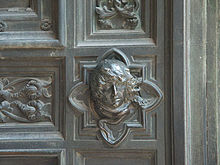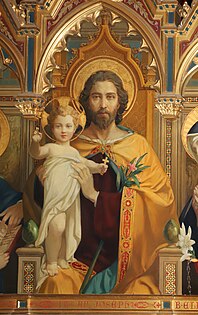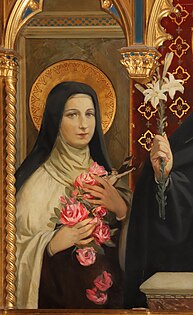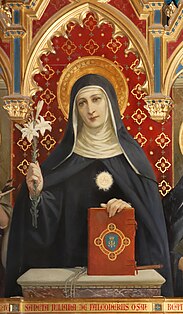Giuseppe Cassioli
Giuseppe Cassioli (22 October 1865 – 5 October 1942)[1] was an Italian painter and sculptor known for his Summer Olympic Games medal design. Many of his paintings are on display at the Museo Cassioli di Pittura senese dell'Ottocento in Asciano, Tuscany.[2]
Biography[edit]

Cassioli was born in Florence, Italy to Amos Cassioli, who himself was a well-known painter and went on to mentor his son. Tito Sarrocchi taught Cassioli techniques in sculpting. In 1885 he exhibited at the Academy of Fine Arts in Siena with a painting inspired by Victor Hugo's Toilers of the Sea.
He worked in the memorial hall of the Palazzo Pubblico in Siena. In 1900 he created the monument to composer Gioachino Rossini in the Basilica of Santa Croce,[3] which was followed by sculpted decorations for the stock exchange in Odessa, and statues and carvings for Arezzo Cathedral. He also produced several paintings for the Church of the Seven Holy Founders in Florence.
Cassioli sculpted the right-hand bronze door for Florence Cathedral[3] which brought about years of criticism and harassment to the point where he created a self-portrait depicting himself being suffocated by a snake.
The Olympic medal[edit]

In 1923 the International Olympic Committee (IOC) launched a competition for sculptors to design the medals for the Summer Olympic Games. Cassioli's Trionfo design was chosen as the winner in 1928.[3][4][5] The obverse incorporated Nike, the Greek goddess of victory, holding a winner's crown and palm with a depiction of the Colosseum in the background.[3] In the top right section of the medal a space was left for the name of the Olympic host and the Games numeral. The reverse features a crowd of people carrying a triumphant athlete. His winning design was first presented at the 1928 Summer Olympics in Amsterdam. The competition saw this design used for 40 years until the 1972 Summer Olympics in Munich became the first Games with a different design for the reverse side of the medal.[4][6]
Cassioli's design continued to inspire the obverse of the medal for many more years, though recreated each time, with the Olympic host and numeral updated. The trend ended in 2004 due to the negative publicity in reaction to the design of medal for the 2000 Summer Olympics in Sydney. Wojciech Pietranik, the designer of the medal, along with the organisers of the Games were criticised by the Greek press for using the Roman Colosseum rather than the Greek Parthenon.[4] Pietranik defended himself by stating that the Australian Olympic Committee had instructed him to use Cassioli's 1928 design as a template.[7] The error had remained for 76 years until a new style depicting the Panathinaiko Stadium was introduced at the 2004 Summer Olympics in Athens.[8]
Gallery[edit]
-
Left panel of triptych depicting Saint Anne teaching the young Virgin Mary how to read
-
Central panel of triptych depicting Saint Joseph holding the Christ Child
-
Right panel of triptych depicting Elisabetta Picenardi
-
Left panel of triptych depicting Saint Thérèse of Lisieux
-
Central panel of triptych depicting Saint Juliana Falconieri
-
Right panel of triptych depicting Giovanna Soderini
References[edit]
- ^ Winner Medals Archived July 4, 2011, at the Wayback Machine, Olympic Games Museum. Accessed 27 July 2011.
- ^ Musei Senesi, picture from Cassioli Museum.
- ^ a b c d Winner's medal for the 1948 Olympic Games in London, Olympic.org. Accessed 5 August 2011.
- ^ a b c London 2012: Olympic medals timeline, BBC News. Accessed 27 July 2011.
- ^ Olympic Summer Games Medals, Athens Info Guide. Accessed 27 July 2011.
- ^ "Giuseppe Cassioli". Olympedia. Retrieved 29 July 2020.
- ^ Greek anger at Olympic medal design, The Telegraph. Accessed 5 August 2011.
- ^ Athens' New Olympic Medal Design Win IOC's Nod, People Daily. Accessed 5 August 2011.
- 1865 births
- 1942 deaths
- Artists from Florence
- 19th-century Italian painters
- Italian male painters
- 20th-century Italian painters
- 19th-century Italian sculptors
- Italian male sculptors
- 20th-century Italian sculptors
- 20th-century Italian male artists
- Olympic competitors in art competitions
- 19th-century Italian male artists






